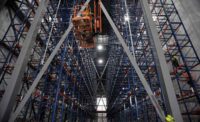Worker Shortages
The biggest concern for contractors going forward is the expected shortage of workers. "The craft labor shortage is something we, as an industry, have spoken about for years but seem to have done little to improve. It is right at our front door now and may very well be the biggest challenge we face as work demands increase and the labor pool shrinks," says McCarthy of PC Construction.
Currently, firms point to pockets of worker shortages, such as in Texas and the Gulf Coast, Boston or Los Angeles. But many contractors say the problem will affect the entire industry. "It doesn't matter where you are in the country or if you work union or nonunion, everybody is worried," says Bolen. "It is a national problem, but it is being handled on a local basis."
Some contractors hope immigration reform may help ease the problem. But Bolen warns against cutting corners in recruiting craft labor. U.S. Immigration and Customs Enforcement has been cracking down on the use of undocumented immigrant workers. "You have to be very careful to verify," he says. "It is the contractors that get sloppy with their employment verification processes that get into trouble."
There are many contractors that fear the work of their subs, feeling the pinch of labor shortages, may suffer. "We are experiencing more subcontractors using labor brokers to provide the capacity they are chasing. Unfortunately, in many instances, this labor force does not have an attachment to their employer and is more likely to be have issues with productivity and working safely," says Rick Whitney, CEO of Adolfson & Peterson Construction.
Firms are taking a variety of approaches to attract and retain both new and experienced people. Bechtel is continuing its program to hire military veterans. "We are approaching 1,000 veterans hired. We believe it is important to help returning vets transition to good jobs here at home," Bechtel says. "Our goal is to become the employer of choice in the industry to ensure our future workforce will be sufficient."
Many contractors are taking steps to ensure they retain the staff they already have. For example, LeChase Construction is supplying career training and mapping for its employees and focusing on continued growth and promoting from within, says William H. Goodrich, CEO. "We've been very organic with growing our employees into leaders within the company."
Hoar Construction has invested in a new human-resources staff and technology to recruit and retain skilled superintendents, project managers, estimators, engineers and administrative staff, says Rob Burton, CEO. He says Hoar will "support our employees' careers with us through continued training, which helps with retention. Once we recruit and train great employees, we want to keep them."
Many contractors are partnering with local schools to foster industry recruitment. "We have established informal mentoring programs at our jobsites and regularly contribute surplus materials to the local technical schools for their training programs," says Griffin of Gemma Power Systems.
Many contractors are gearing their employment practices to accommodate younger professionals to lure and retain them. "At Alston, we have created a culture that places high value on our people as whole, both at work and at home," says Paul D. Little, CEO of Alston Construction. Maintaining an appropriate "work-life balance" is something the firm recognizes and values, he says.
From Novelty to Necessity
Technology is no longer a value added or luxury; it is a necessity for business at all levels of the construction process, from design to project completion. PCL continues to look for new technologies to drive efficiencies in its business. For example, "we are working with new mobile applications to enhance our lean construction methods, specifically around Last Planner for pull planning," says Shaun Yancey, president of PCL US Operations. He says PCL has staff working with software vendor Autodesk to develop a Last Planner app that staff can use via the web and on tablets.





Post a comment to this article
Report Abusive Comment